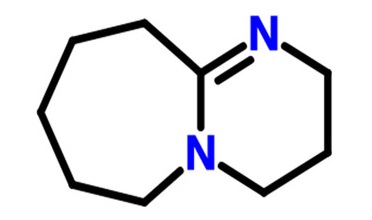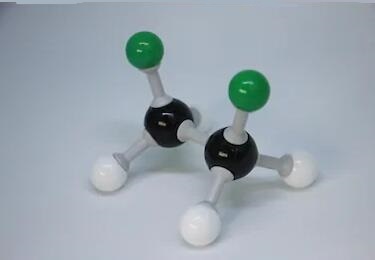What is 1,8-Diazabicyclo[5.4.0]undec-7-ene?
Jul 15,2020
Description
1,8-Diazabicyclo[5.4.0]undec-7-ene is a bicyclic amidine base. It is non-nucleophilic, sterically hindered, tertiary amine base in organic chemistry. It is reported to be superior to amine catalyst in Baylis-Hillman reaction. It promotes the methylation reaction of phenols, indoles and benzimidazoles with dimethyl carbonate under mild conditions.
Uses
1,8-Diazabicyclo[5.4.0]undec-7-ene is used in organic synthesis as a catalyst, a complexing ligand, and a non-nucleophilic base. It is used as a protecting agent for the synthesis of cephalosporin and as a catalyst for polyurethane. 1,8-Diazabicyclo[5.4.0]undec-7-ene (DBU) may be used:
- as catalyst for carboxylic acid esterification with dimethyl carbonate in the synthesis of duocarmycin and CC-1065 analogs;
- as catalyst in aza-Michael addition and Knovenegal condensation reaction;
- as base for dehalogenation of halogenated Diels-Alder adducts and the resulting activated 2,4-dienones were subjected to regio- and stereo-directed Michael additions, using Yamamoto′s reagent (CH3Cu · BF3) in a new synthesis of the ABCD ring system of Camptothecin;
1,8-Diazabicyclo[5.4.0]undec-7-ene may be used as an catalyst for the dissolution and activation of cellulose by a reversible reaction of its hydroxyl groups with carbon dioxide. This dissolved cellulose system can be derivatized to form cellulose mixed esters.
Purification Methods
Fractionally distil DBU under vacuum. Also purify it by chromatography on Kieselgel and eluting with CHCl3/EtOH/25% aqueous NH3 (15:5:2) and checking by IR and MS. [Oediger et al. Chem Ber 99 2012 1962, Angew Chem, Int Ed Engl 6 76 1967, Guggisberg et al. Helv Chim Acta 61 1057 1978, Beilstein 23/5 V 271.]
Health Hazard
- Inhalation: Remove victim to fresh air and keep at rest in a position comfortable for breathing. Immediately call a POISON CENTER or doctor/physician.
- Skin contact: Remove/Take off immediately all contaminated clothing. Gently wash with plenty of soap and water. Immediately call a POISON CENTER or doctor/physician.
- Eye contact: Rinse cautiously with water for several minutes. Remove contact lenses, if present and easy to do. Continue rinsing.Immediately call a POISON CENTER or doctor/physician.
- Ingestion: Immediately call a POISON CENTER or doctor/physician. Rinse mouth. Do NOT induce vomiting.
- Protection of first-aiders: A rescuer should wear personal protective equipment, such as rubber gloves and air-tight goggles.
Firefighting measures
- Extinguishing media Suitable extinguishing media: Dry chemical, foam, water in large amounts, carbon dioxide.
- Special hazards arising from the substance or mixture: Take care as it may decompose upon combustion or in high temperatures to generate poisonous fume.
- Carbon dioxide, Carbon monoxide, Nitrogen oxides (NOx)
- Advice for firefighters: Fire-extinguishing work is done from the windward and the suitable fire-extinguishing method according to the surrounding situation is used. Uninvolved persons should evacuate to a safe place. In case of fire in the surroundings: Remove movable containers if safe to do so. When extinguishing fire, be sure to wear personal protective equipment.
Accidental release measures
- Personal precautions, protective equipment and emergency procedures
- Use personal protective equipment. Keep people away from and upwind of spill/leak. Ensure adequate ventilation. Entry to non-involved personnel should be controlled around the leakage area by roping off, etc.
- Environmental precautions
- Prevent product from entering drains
- Methods and materials for containment and cleaning up
- Absorb spilled material in a suitable absorbent (e.g. rag, dry sand, earth, saw-dust). In case of large amount of spillage, contain a spill by bunding. Adhered or collected material should be promptly disposed of, in accordance with appropriate laws and regulations.
- Handling and storage
- Precautions for safe handling
- Handling is performed in a well ventilated place. Wear suitable protective equipment. Prevent generation of vapour or mist. Wash hands and face thoroughly after handling. Use a closed system if possible. Use a ventilation, local exhaust if vapour or aerosol will be generated. Avoid contact with skin, eyes and clothing.
- Conditions for safe storage, including any incompatibilities
- Keep container tightly closed. Store in a cool and dark place. Store under inert gas.
- Store locked up. Store away from incompatible materials such as oxidizing agents.
- Air-sensitive
- Related articles
- Related Qustion
- 1,8-Diazabicyclo[5.4.0]undec-7-ene: a useful organic reagent Apr 16, 2024
1,8-Diazabicyclo[5.4.0]undec-7-ene, also known as DBU or Diazabicycloundecene, is used as a complexing ligand, a catalyst, and a non-nucleophilic base in organic synthesis.
- DBU: Applications and Preparation Apr 20, 2023
1,8-Diazabicyclo[5.4.0]undec-7-ene (DBU) is a bicyclic organic compound with the chemical formula C9H16N2. It is a colorless liquid and is commonly used as a strong base in organic chemistry.
Lithium titanate (Li4Ti5O12) is a type of lithium-titanium composite oxide with a spinel structure. It has the advantages of cheap availability, safe and reliable, simple preparation process, low cost, good cycle performance, high chemical....
Jul 15,2020Inorganic chemistry1,2-Dichloroethane, also called ethylene dichloride (EDC), is a manufactured chemical that is not found naturally in the environment. It is used principally to synthesize vinyl chloride.....
Jul 17,2020Hydrocarbons and derivativesDBU
6674-22-2You may like
- The benefits of Milk Thistle Seed Oil
Apr 16, 2024
- Abametapir:Introduction and Synthesis
Dec 25, 2023
- 2,2′:6′,2″-terpyridine-Application
Feb 18, 2020
- 1,8-Diazabicyclo[5.4.0]undec-7-ene
-
![6674-22-2 1,8-Diazabicyclo[5.4.0]undec-7-ene](/ProductImageEN1/2025-04/Small/f55e60c0-f26d-4ecd-966b-f4ae0a47475b.gif)
- 2025-12-20
- CAS:6674-22-2
- Min. Order:
- Purity: 0.99
- Supply Ability:
- DBU
-

- $0.00 / 1kg
- 2025-12-19
- CAS:6674-22-2
- Min. Order: 1kg
- Purity: 99%
- Supply Ability: 20MT
- DBU
-

- $0.00 / 25KG
- 2025-12-19
- CAS:6674-22-2
- Min. Order: 25KG
- Purity: 98%min
- Supply Ability: 30tons/month







